Baby Seahorse & Invisible Octopus
 August 2, 2012
August 2, 2012
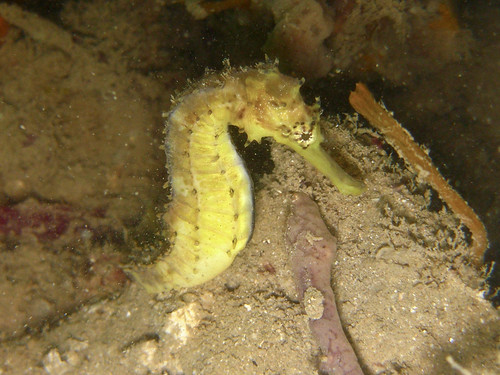
Tiger-tail seahorse (Hippocampus comes) PHOTO: Lam Pei Min/Hantu Blog
Low visibility conditions continue to keep the reefs of Pulau Hantu in the shadow, that is, until our volunteers show up to shed some light! Divers reported “good diving” over the last weekend of July, and understandably so – we haven’t seen seahorses in quite awhile. Though they are known to be common on our reefs, local seahorse populations are small and vulnerable to over harvesting by collectors for the aquarium trade. Every time we see some on the reef, we feel hopeful that our reefs have a chance to visit the future.
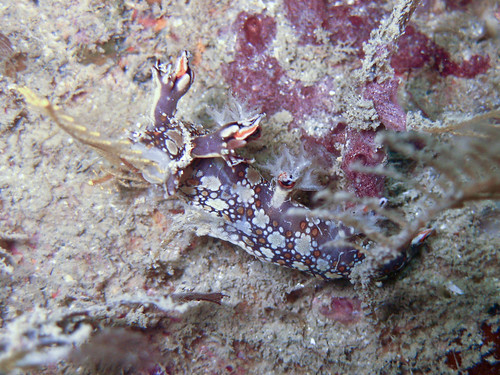
Bornella anguilla (Snakey bornella) PHOTO: Lam Pei Min/Hantu Blog
It seems to be spring time on the reef. Over the week we found two cuttlefish nests, and on this dive we witnessed a pair of Snakey bornellas, and a pair of Gymnodoris rubropapulosa mating. In the above photo, we can clearly see the white-coloured mouth parts of this Snakey bornella as it feeds on a hydroid.
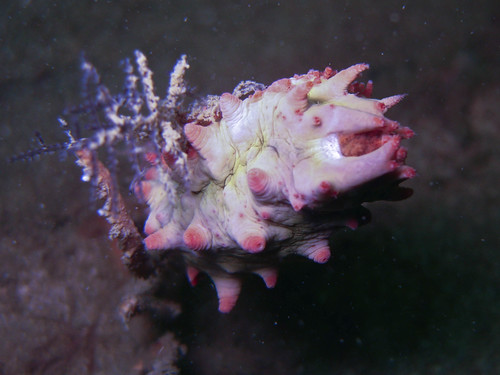
Thorny sea cucumber (Colochirus quadrangularis) PHOTO: Lam Pei Min/Hantu Blog
The Thorny sea cucumber is a colourful sea cucumber that can also be commonly seen in the intertidal zone during the low tide. It can grow up to 10cm long, and while its thorns and striking colours make it appear formidable, it is harmless. It feeds on plankton, and like the seahorse, it is vulnerable to over-collection by the aquarium trade.
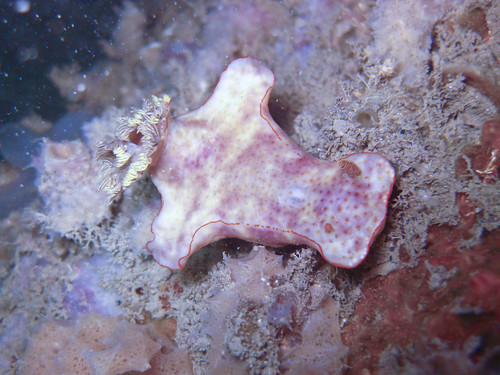
Slender ceratosoma (Ceratosoma gracillimum) PHOTO: Lam Pei Min/Hantu Blog
Though we have seen them several times, it’s always a delight to spot a Slender ceratosoma on the reef. Though it looks outstanding in this picture with its wing-like appendages, when looking at the reef, the Slender ceratosoma is easy to miss because it resembles many of the sponges that it is commonly found foraging amidst.

Crocodile flathead PHOTO: Lam Pei Min/Hantu Blog
A pair of good eyes on the reef will be able to spot creatures that are good at remaining still and appearing invisible, such as this tiny baby Crocodile flathead. Adult Crocodile flatheads tend to partially bury themselves into the sediment along the reef flat. This little one better learn to do that soon if it is to avoid becoming a meal for larger carnivorous fish!
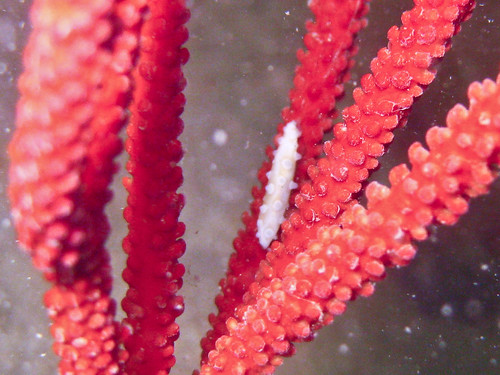
Allied cowrie on whip coral PHOTO: Lam Pei Min/Hantu Blog
Allied cowries tend to mimic the host coral on which they live. Perhaps this allied cowrie only recently migrated to this red-coloured whip coral colony.
Gorgonians are generally unpalatable and are thus avoided by most predators. By closely resembling the gorgonian, the mollusk also gains protection from predators. Only the mollusk, however, benefits from this relationship.
Allied cowries are, in fact, parasites that harm their host. They feed on the host’s tissues, mucus and polyps and absorb pigments that enable the cowries to closely match the host’s color. The host continually regrows the lost tissue so the cowrie never runs out of food. [1]

Doto sp. and marine bryozoan on hydroid PHOTO: Lam Pei Min/Hantu Blog
Though the focus of the above picture would be the Doto nudibranch (small, yellow-coloured sea slug on the hydroid) very little is known about them. Perhaps more interesting but often over-looked is the marine lace-like bryozoan that cab also be seen in this picture, just above and to the right of the Doto nudibranch. Looking like an inanimate piece of fabric lodged onto the hydroid, marine bryozoans produce chitinous spines that protrude from the corners of each individual zooid, in response to predation by several species of nudibranchs, its primary predator. These spines make it difficult for the nudibranchs to access the polypide (the organs and tissues) of the zooid. However, the energy and resources needed to produce the spines also results in decreased growth and reproduction of the colony. Other predators of marine bryozoans include fish, sea urchins, pycnogonids, crustaceans, mites and starfish. In general marine echinoderms and molluscs eat masses of zooids by gouging pieces of colonies, breaking their mineralized “houses”, while most arthropod predators on bryozoans eat individual zooids.[2]
Several species of the hydroid have symbiotic relationships with bryozoans, some of which are beneficial to the hydroids while others are parasitic. Modifications appear in the shapes of some these hydroids, for example smaller tentacles or encrustation of the roots by bryozoans. The bryozoan Alcyonidium nodosum protects the whelk Burnupena papyracea against predation by the powerful and voracious rock lobster Jasus lalandii. While whelk shells encrusted by the bryozoans are stronger than those without this reinforcement, chemical defenses produced by the bryozoans are probably the more significant deterrent.
Marine bryozoans are often responsible for biofouling on ships’ hulls, on docks and marinas, and on offshore structures. They are among the first colonizers of new or recently cleaned structures. [3]
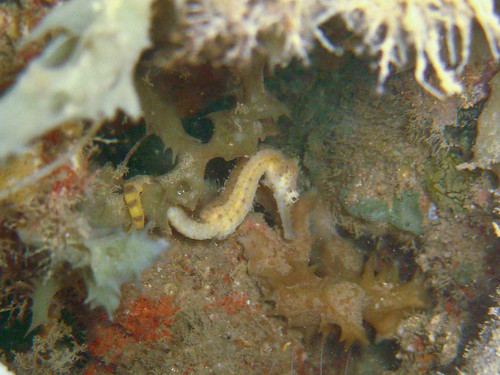
Juvenile Tiger-tail seahorse (Hippocampus comes) PHOTO: Lam Pei Min/Hantu Blog
A young Tiger-tail seahorse holds onto some branching sponge with its tiger-striped, prehensile tail.

Octopus PHOTO: Lam Pei Min/Hantu Blog
For our divers, the highlight of the dive was spotting this creature that is evidently a master of camouflage! Partially buried within the sediment, with just one eye and the top of its head visible, is a small octopus! The common octopus can change its appearance to hide from predators—and prey, in an instant! Using a network of pigment cells and specialized muscles in its skin, the common octopus can almost instantaneously match the colors, patterns, and even textures of its surroundings. Predators such as sharks, eels, and dolphins swim by without even noticing it.
Despite its irregular shape, octopi are fast swimmers. They can jet forward by expelling water through their mantles, and their soft bodies can squeeze into impossibly small cracks and crevices where predators can’t follow.
If all else fails, an octopus can lose an arm to escape a predator’s grasp and regrow it later with no permanent damage. They also have beaklike jaws that can deliver a nasty bite, and venomous saliva, used mainly for subduing prey.
Considered the most intelligent of all invertebrates, the common octopus is found througout Singapore waters, and can even be found along the mainland coast. They prey on crabs, crayfish, and mollusks, and will sometimes use their ink to disorient their victims before attacking.
To see more pictures from this dive, visit the Hantu Blog Gallery!
 Posted in
Posted in 



 content rss
content rss
COMMENTS